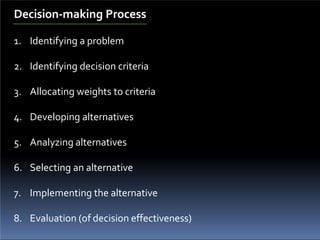This document provides an overview of decision making processes. It discusses key topics like the decision making stages, models, styles, and implementation. The rational and bounded rational models of decision making are described. The seven step decision making process involves defining goals, gathering data, brainstorming alternatives, analyzing pros and cons, making the decision, taking action, and reflecting on the outcome. Group decision making has four stages: orientation, conflict, emergence, and reinforcement. Tools like Pareto analysis, SWOT analysis, and orienting SWOTs to objectives are also summarized.








































